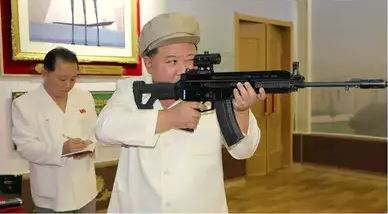State media in North Korea said on Thursday that as the United States and South Korea prepared for a large-scale joint military drill, Kim Jong Un had instructed his military to improve its war preparations and approved boosting the combat activities of frontline troops.
As tensions on the Korean Peninsula reach their highest point in years, Kim uses the allies’ expanding drills as an excuse to speed up his weapons demonstrations, which have included the test-firings of more than 100 missiles since the beginning of 2022.
To negotiate economic and security concessions from a position of strength, experts think Kim wants to make the United States accept the notion of the North as a nuclear power.
Kim, as chairman of North Korea’s ruling Workers’ Party, called a meeting of the party’s central military commission on Thursday to discuss increasing the combat readiness of his military and developing offensive countermeasure plans to deter his enemies, who, according to state media, are becoming more brazen in their “reckless military confrontation” with the North.
Following discussions on strengthening North Korea’s frontline forces and increasing war exercises to include new techniques and weapons, Kim issued an order to execute unspecified “important military measures,” according to Pyongyang’s official Korean Central News Agency.
Kim emphasised the need of acquiring “more powerful strike means” to strengthen his nuclear deterrence and speeding up the deployment of such weapons to combat troops during the meeting. According to KCNA, he urged the munitions sector to increase manufacture of weapons and systems on a large scale, and the armed forces to perform “actual war drills” to better absorb and use the new technology.
Photos from the meeting released by the government media showed Kim pointing at various locations on a hazy map of the Korean Peninsula. It seemed like the areas were in and around Daejeon, the core city of South Korea and the home of the country’s army headquarters, and the metropolitan area around Seoul, where half of the country’s 51 million inhabitants dwell.
KCNA said that Kim replaced Gen. Pak Su Il with Vice Marshal Ri Yong Gil as head of general staff at the meeting.
Since taking power in late 2011, Kim has demonstrated a propensity to quickly replace top government and military leaders if he is dissatisfied with their performance or needs to hold them accountable for larger policy failings, which the North never attributes to its supreme commander.
According to Cheong Seong-Chang, a senior analyst at South Korea’s Sejong Institute, Kim’s decision to fire Pak eight months into the job suggests that he was dissatisfied with Pak’s ability to craft military strategies and returned to a more trusted hand in Ri, who had a lengthy previous stint as chief of general staff.
In response to Kim’s remarks, South Korean Foreign Ministry spokesman Ahn Eun-ju called it “deplorable” that North Korea was discussing increasing its war preparation while neglecting the misery of its severely impoverished citizens. The North Korean economy is reportedly at its weakest point since Kim assumed control, according to some analysts. COVID-His nuclear aspirations led to the imposition of 19 limitations, which further shook an economy already weakened by decades of mismanagement and U.S.-sponsored sanctions. Despite this, Kim continues to invest the country’s few resources on building up a nuclear arsenal, which he views as his best defence.
Instead, “North Korea should pay attention to the safety of its citizens with a typhoon approaching,” Ahn added, referring to Tropical Storm Khaunun, which lashed South Korea with heavy rains and gusts on Thursday and was forecast to hit North Korea early on Friday.
She emphasised that the United States is keeping a “firm readiness posture” and that North Korea’s “empty threats of force” will not be tolerated.
During a briefing, South Korean Joint Chiefs of Staff spokeswoman Lee Sung Joon said that the United States and South Korea were keeping a careful eye on North Korea’s weapons development efforts and potential for provocations.
Kim called for significant improvements to the country’s arms and war readiness during the meeting, echoing comments he made last week during a three-day tour of the country’s key weapons factories. These included a facility that produces launcher trucks for his intercontinental ballistic missiles designed to target the U.S. mainland.
Since Kim visited an artillery plant, it has been speculated that North Korea is getting ready to transfer artillery and other weaponry supplies to Russia in response to President Vladimir Putin’s efforts to rally international support for Russia’s involvement in the conflict in Ukraine.
Kim has been seeking to break out of diplomatic isolation and integrate himself into a unified front against the U.S. by increasing the prominence of his alliances with Moscow and Beijing as tensions rise with Washington and Seoul.
At a massive military display in Pyongyang, Kim unveiled his most powerful missiles intended to attack South Korea and the United States with Russian Defence Minister Sergei Shoigu and a Chinese ruling party leader. Kim hosted Shoigu at a domestic weapons expo on July 27, leading up to the parade, furthering fears that North Korea was prepared to transfer guns to Russia in response to Russia’s invasion of Ukraine.
North Korean authorities decided to perform another military parade on the 75th anniversary of the country’s creation during Thursday’s summit. The parade on September 9 would be the third major event in the nation in 2023. According to experts, the North has never had more than two military parades in a single year.

